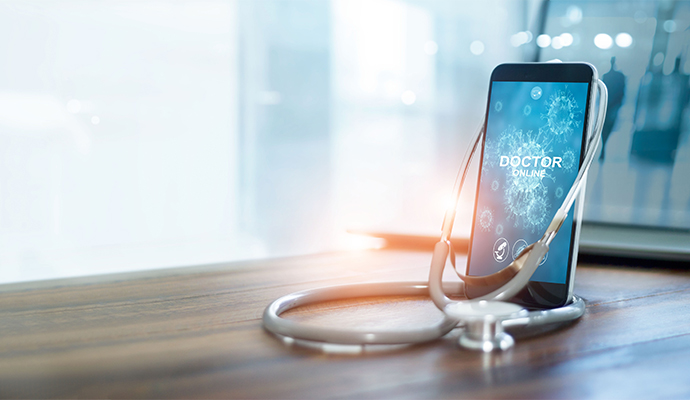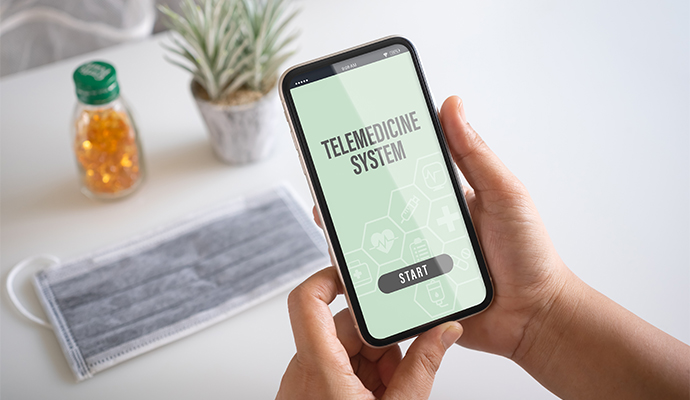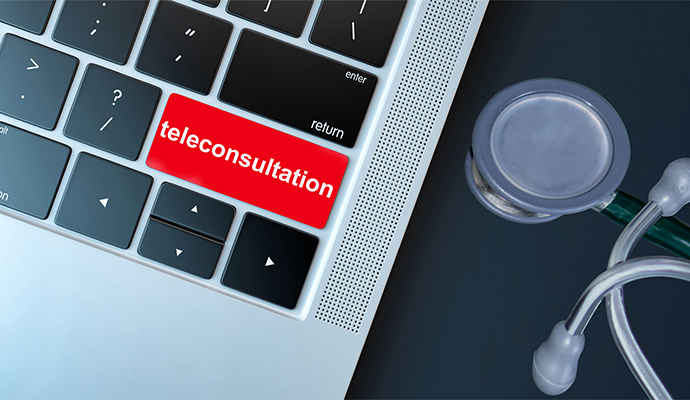COVID-19 Gives Providers a Blueprint for New Telehealth Strategies
The lessons learned in applying telehealth and mHealth to a pandemic will help health systems and hospitals shape their connected health strategies far beyond this crisis.

It’s been said, rightly and tragically so, that it took a pandemic to prove the value of telehealth to the American healthcare system.
As health systems and hospitals adjust their workflows to deal with the coronavirus pandemic, they’re learning some valuable lessons on how to best use connected health technology. With in-person care reduced to emergencies and an emphasis on keeping patients and providers separated, they’re using telemedicine platforms and mHealth devices – including the telephone – to deliver care.
And they’re planning beyond the COVID-19 crisis, with telehealth front and center.
Expanding – Temporarily – the Telehealth Playing Field
At the onset of the pandemic, state and federal regulators moved quickly to reduce the barriers to telehealth adoption, understanding that these new tools could speed access to care while protecting healthcare workers.
The Centers for Medicare & Medicaid Services (CMS) launched several emergency initiatives that expanded Medicare and Medicaid coverage, including increasing the types of providers able to use telehealth, allowing providers more freedom to use different modalities – such as remote patient monitoring and phone-based services – and expanding the number of sites qualifying for coverage to include homes, federally qualified health centers, and rural clinics.
State regulators added their own emergency directives, expanding Medicaid coverage, enabling more care providers to use telehealth, requiring private payers to cover telehealth services and, in some cases, tweaking the rules to allow out-of-state providers to use telehealth to treat residents and providers in the state to treat residents of other states.
Other federal agencies took action as well. With Congress passing and President Trump signing into law a series of coronavirus relief bills, Washington opened the purse strings for a number of telehealth projects. The Health and Human Services Department dished out a number of grants and awards, while the Federal Communications Commission launched its own $100 million COVID-19 Telehealth Program, aiming to support broadband expansion projects that pushed new telehealth services into rural areas where connectivity isn’t great.
Those measures opened the floodgates for telehealth, allowing for new programs and the expansion of existing networks. In April, a survey of some 1,300 physicians by the online physician network Sermo found that 90 percent were using at least some form of telehealth and 60 percent were planning to continue that practice after the emergency. In May, a survey of hospitals and health system executives by Xtelligent Healthcare Media put that number at 63 percent, well above the 20 percent adoption rates seen prior to the pandemic.
“Telehealth has been the missing element to how we deliver healthcare,” says Mei Kwong, executive director for the Center for Connected Health Policy, one of a handful of organizations that have been keeping track of telehealth use during the pandemic. “But now people are familiar with it. They now have the experience and will want to see it used more often.”

Putting Telehealth on the Front Doorstep
One recurring trend that seems likely to continue is the idea of telemedicine triage.
Faced with separating patients infected – confirmed or potentially - with the coronavirus from care providers and other patients, many health systems developed a telemedicine platform or expanded existing services to screen patients away from the facility. Patients talked by phone with a call center or care provider or entered symptoms on an mHealth app or website, after which they were told to either stay home or head to the hospital or clinic. More sophisticated programs used audio-visual telemedicine platforms to arrange virtual visits.
For those patients who did show up, hospitals created isolation rooms or wards and used kiosks or telemedicine platforms to interact.
“Tele-triage has always been of real interest,” Andrew Watson, MD, MLitt, FACS, UPMC’s medical director of telemedicine and vice president of clinical Information technology transformation, said during a recent Twitter forum on telehealth. “This also has real implications for rural hospital intensive care units and emergency departments. The costs and challenges of travel/transport for patients and payers are significant.”
From a patient standpoint, “a lot of people will now see telehealth as their first point of contact for urgent care,” says Ethan Booker, MD, medical director of Maryland-based MedStar Health’s Telehealth Innovation Center and the MedStar eVisit platform.
Booker says the coronavirus is giving healthcare providers the confidence to use telehealth and mHealth tools more often for that first point of contact, to assess what their patients need and decide on a course of action that reduces wasteful expenses and improves quality of care.
“Doctors have been answering e-mails and phone calls for a long, long time,” he adds. “That hasn’t changed. But this expands the toolkit.”
Shining a Light on Remote Patient Monitoring
With the COVID-19 crisis forcing healthcare providers to separate patients from providers, many are using remote patient monitoring platforms to provide care for infected and potentially contagious patients in their own homes.
It’s a tailor-made opportunity for a service that has been slowly and steadily gaining attention over the past few years. With CMS beginning to offer some reimbursement for certain services delivered to the home, providers have been trying out telemedicine platforms and mHealth devices, even looking into the smart home concept.
“We are learning a lot,” says Booker. “Telehealth provides the opportunity to move from a highly scheduled and (episodic) experience to a much more relational experience for both patients and providers. We need to remember that as we move on.”
That relationship, he says, will also move into the home. Telehealth and remote patient monitoring services provide a continuous, data-rich platform that connects providers to patients at any time, rather than just when the patient comes to the provider. Having learned how to manage patients with COVID-19, providers can now pivot to manage patients with chronic care needs, or those who’ve just been released from the hospital, or those who frequently visit the hospital, in their homes.
“We are now understanding the value of the home setting,” Booker says.
In Illinois, OSF HealthCare launched an RPM program in April, sending an mHealth kit to hundreds of patients and having them check in with nurses at a newly launched call center.
“We’ve been brainstorming a lot of different ideas, and this … is the right way to bring healthcare out into the community,” says Jennifer Junis, the health system’s senior vice president. “It gives us a layered approach” to treating patients infected with the virus.
Junis says the health system will pivot the program to new populations once the pandemic ends, as well as creating a model for deployment during future emergencies.

Lessons Learned From the Front Lines
When the coronavirus hit, front-line hospitals saw their telehealth services surge. Some providers struggled to keep up with the demand, either by not having enough doctors trained in telehealth to handle the increased caseload or relying on a telehealth vendor that didn’t have the available resources to keep the online platform running smoothly.
Some telehealth experts have suggested that the pandemic may shake up the industry. Some of the bigger vendors, having weathered the storm, will stake out their ground, while smaller companies will either drop out or focus on specific pain points, specialties, or services, like eConsults. On the flip side, providers large and small may rethink their telehealth strategy, choosing to put their resources into their own service lines rather than a hosted platform.
At UC San Diego Health, a virtual visit platform that had seen perhaps 800 visits over the past three years soared past that mark in two days, says Marc Sylwestrzak, director of IS experience and digital health. And where video visits once comprised a small percentage of overall visits, more than half of all visits were virtual at the height of the pandemic.
“Turning this on for everyone was huge for us,” says Sylwestrzak, “but we were forced to accept it by the circumstances.”
“From a technical standpoint, we had the pieces in place,” he adds. “We’d been doing telehealth, but on a small scale. We knew the technology, but the biggest thing was trying to stay ahead.”
Sylwestrzak says the health system trained some 300 employees quickly, bringing everyone up to speed in a matter of days. What they didn’t expect, though, was that so many of their patients needed to be taught how to use telehealth.
“Our call center was swamped,” he says.
That’s the lesson learned from UCSD Health. For a health system to see success in launching or scaling up a telehealth service, remember to train not only the providers, but also the patients. Pour resources into patient outreach ahead of the go-live, teaching them how to use the new service, and beef up the call center to handle any surge of confused patients.
As the nation moves beyond COVID-19, Sylwestrzak sees UCSD Health moving in two directions with its connected health services. Like so many other health systems, they’ll be taking more interest in RPM programs, particularly for chronic care management in the home.
“That’s going to be a future for us, for sure,” he says.
The health system will also be looking inwards – back into the hospital setting. Sylwestrzak says they’ll be working on telemedicine platforms that allow care providers to monitor and check in on patients without actually having to go into the room. Such platforms would allow doctors to monitor multiple patients at the same time, checking on vital signs, and even talking to the patient, family members, or nurses.
“In-patient telehealth is going to be another big area for us,” he says. “This definitely won’t take the place of face-to-face care, but we can do a lot more with telehealth” that looks into the room and connects the patient with providers, including specialists, in other locations.
On the other side of the country, MedStar’s Booker offers similar statistics. Telehealth volume at the 10-hospital network jumped from two visits a week to as high as 4,000 in one day, totaling more than 51,700 visits in just the first month. Combined, outpatient and urgent care visits by telehealth increased by more than 500 percent the week of April 12.
“Our biggest challenge had been getting people to do it once or twice,” says Booker. “Now the genie is out of the bottle.”
On the other side of the coin, he said the emergency is teaching consumers how to use telehealth to “navigate the system better.”
Changing the Paradigm of In-patient Care
With the virus forcing health systems to separate potentially infected patients from staff and other patients, many hospitals introduced or upgraded their in-patient telemedicine platforms. Rooms, and in some cases entire wings, were turned into isolation units, with connected devices and audio-visual systems enabling providers to monitor patients form the outside.
At Houston Methodist, roughly 120 ICU beds were fully integrated with a telemedicine platform by February, in a project begun last July, long before COVID-19 was a thing. So when the surge hit in early April and infected patients jumped from 24 to 126 in two days, officials were ready.
Roberta Schwartz, PhD, the health system’s executive vice president and chief innovation officer, says Houston Methodist now has a system in place “that basically sucks in all of the data from our EMR and all of the other machines (in the patient’s room) and gives us a detailed, easy-to-read summary” of the patient’s condition.
All of those patients are now monitored in a virtual ICU command center, reducing traffic in and out of each room and fine-tuning workflows so that doctors and nurses are only dispatched when they need to be dispatched, rather than running errands or checking up on potential concerns.
“People weren’t culturally ready for a virtual ICU at first,” Schwartz says. But the COVID-19 crisis “helped us along. We had to adjust quickly.”
Schwartz says this setup will offer benefits long after the pandemic has passed, allowing the hospital to assemble care teams for each patient that don’t have to be at that patient’s bedside, but can check in virtually when needed. That popular picture of a crown of doctors and family members around the patient’s bed can be replaced by one or two nurses, a hospitalist in the command center, and specialists and family members patched in on video for daily updates.
At Florida’s Jackson Health System, hospital officials equipped patient rooms with an mHealth platform developed by Cerner, allowing doctors and nurses to monitor and communicate with patients without entering the room.
“We’ve reduced the number of times [staff] have to go into the room,” says Michael Garcia, the Miami-based health system’s chief information officer. “This is important not only for those infected with COVID-19, but for other patients. Even if they’re not infected with COVID, we need to make sure we’re not contaminating them in any way.”
Garcia says the network, which allows one doctor or nurse to monitor several patient rooms, not only reduces the amount of contact between patients and staff, but also frees doctors and nurses from clambering into and out of personal protective equipment (PPE).
The platform also gives Jackson Health a model for the future, enabling care providers to keep track of patients in several rooms at once and communicate with them whenever necessary.
“This should be the norm,” says Garcia.
At Phoenix Children’s Hospital, officials weren’t worried so much about dealing with COVID-19 patients as they were with keeping in touch with thousands of children and their families who come to the hospital each week for care.
With the emergency all but eliminating unnecessary hospital visits, Phoenix Children’s transitioned some 6,000 in-person appointments onto a telemedicine platform in one week’s time. The hospital repurposed a clinician-to-clinician service to meet the needs of families calling or logging in for primary and specialist care.
“We were watching [the pandemic] very closely,” says Vinay Vaidya, MD, the hospital’s senior vice president and chief medical information officer. “Telemedicine had been on our horizon for quite some time, but the virus forced us to ramp up very rapidly.”
By the middle of March, Phoenix Children’s was conducting 90 percent of its visits via telehealth, allowing patients and their families to stay home and reduce the risk of contracting COVID-19 at the hospital or on the way to and from the campus. For parents of children with chronic diseases and other serious health issues, the service offered a welcome degree of insulation from a virus that could be very dangerous, even fatal.
Along the way, Vaidya says, hospital staff found that a telehealth visit could replicate many of the traditional in-person services, reducing the burden on stressed families and allowing doctors and nurses to redefine their workloads and focus in-person care on the most critical cases.
“The [pandemic] gave us the shot in the arm we needed to move forward,” says Vaidya, who estimates some 60 percent of the visits are now virtual (they had been at about 5 percent before the pandemic). “This will become a standard of care in a lot more of our offerings.”
Preparing for a Post-Pandemic Reality
Vaidya cautions that a hospital “shouldn’t see the pendulum swing too far in the other direction.” In other words, providers can get too comfortable with virtual visits, and perhaps do more online than they should be doing.
“We are going to handle the routine appointments and look for other ways to use telehealth … and the parents will be asking us to use telehealth,” he says. “But we have to be careful to choose the right way to deliver this. Sometimes an emergency, rightly or wrongly, forces your attention too much on the technology” and not enough on the patient.
Kwong, of the Center for Connected Health Policy, sees a long period of transition ahead.
“It’s going to get interesting,” she says.
For instance, Kwong says, healthcare providers are aware that the changes in telehealth coverage will end with the emergency, and they’ll be prepared for that shift. But most consumers won’t understand or be ready for that change, and they’ll expect as much out of telehealth after COVID-19 as they were getting during the pandemic.
“People are thinking the phone is telehealth,” she notes. “It’s temporarily been brought under the umbrella because of the virus, but that won’t last.”
In addition, she says, many patients will resist going back to their doctor or visiting a hospital, fearful that the virus may still be present. This will affect already-struggling hospitals and practices, many of whom will have to balance a continued interest in telehealth with a changing reimbursement and coverage landscape.
“It’s going to take some time to sort things out,” Kwong says.
Providers are also awaiting how the post-pandemic regulatory and policy landscape shakes out. What emergency measures will expire, and what actions will state and federal regulators take to make sure that telehealth continues to advance and expand? Will CMS continue to support RPM programs by allowing the patient’s home to serve as a telehealth site? Will privacy and security guidelines – most notably HIPAA – be revised to allow providers and patients to connect on more platforms, including the audio-only phone? Will reliable broadband become a reality?
“We have all talked about the new normal but we haven’t seen what the new normal is yet,” says UCSD Health’s Marc Sylwestrzak. “I wouldn’t be surprised if doing 1,000 video visits a day will become the new norm.”
“We won’t be replacing the in-person visit,” he adds. “But we’ve seen now what telehealth can do. It’s allowing us to deliver care that probably wouldn’t happen. This is our future.”




